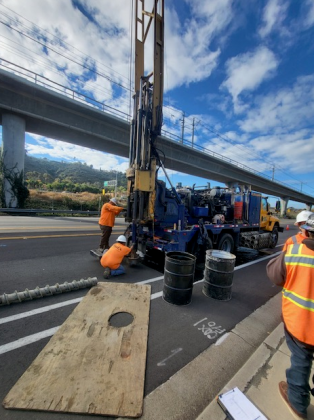By Mike Allen
Photo: construction at night for Advanced Water Purification program
February 6, 2025 (Santee) -- East County’s biggest infrastructure project, Advanced Water Purification, is officially costing more than $1 billion after the Joint Powers Authority that oversees it approved about $80 million in changes to its construction contract.
AWP, planned since 2015 to provide water reliability to the region, was initially estimated to cost about $500 million to build, but by 2021, its former CEO Alan Carlisle told the Santee City Council the new estimate for the program was “north of $600 million.”
Now the cost for construction packages 1 through 4 is more than twice the original estimate. And that’s not counting the cost for package 5, which hasn’t been disclosed because it’s still in the planning stages. However, documents on AWP’s website show an estimate between $100 million and $200 million for a system that converts waste to energy to power the new facility under construction at the end of Fanita Parkway in Santee.
The AWP’s hefty cost is being borne by four partner agencies: Padre Dam Municipal Water District, the city of El Cajon, San Diego County, and Helix Water District.
At the JPA’s November meeting when the amended contract was approved, board president Steve Goble noted the $80 million increase to package 4 was significantly above an original estimate for this phase of $100 million, and asked the reasons behind it. “The public would say that’s a big increase, an 80 percent increase,” he said.
 Photo, right: work on Advanced Water Purification near State Route 52
Photo, right: work on Advanced Water Purification near State Route 52
Rebecca Abbott, the project’s chief engineer, said, “It really boils down to project complexity…it’s what we know now versus what we knew then.”
Melissa McChesney, spokeswoman for Padre Dam WD, said in an email to East County Magazine the key reasons behind the increased costs for package 4 are the complexity of inserting two smaller sewer pipelines into an existing pipe; minimizing construction impacts which extended the construction time from 18 months to 34 months; and the increased costs for labor, materials and equipment rentals.
Among the more expensive elements is a requirement for a force pipeline connecting to the AWP facility to be operating through heavy rain events during construction and providing enhanced protection to Mission Trails Regional Park. Both added about $12 million to the bill. A Caltrans mandate to tunnel beneath State Route 52 added another $10 million, she said.
The good news for the participating agencies and their rate payers is that the city of San Diego is on the hook for most of the increased cost. The JPA’s share is about 39 percent, while the city assumes 61 percent of the residuals line cost, according to JPA documents. That share boosts the cost for the AWP by about $70 million, bringing the revised total for the project to about $1.02 billion, compared to the previous official estimate of $950 million.
All this work is being coordinated with the city as it moves ahead with its own water reclamation system called Pure Water, which will cost about $1.5 billion for Phase I, including the planning, design and construction. Construction on Phase I is over 70% complete. The city hasn’t revealed what the construction cost is.
Water agencies in Southern California have been building these expensive systems in the last several decades as the cost of imported water from Northern California skyrockets, but at least one longtime elected water official says the area doesn’t need it.
“I voted against (AWP) because there’s ample water in the area,” said Dan McMillan, who is a member of Helix Water District’s board and the San Diego County Water Authority.
Reacting to the higher costs, more customers have cut way back on their water use, resulting in surplus supply in much of the San Diego area, McMillan says. But all the water agencies need to maintain their systems, and the cost for doing that is always increasing so that results in water agencies hiking their fees.
While Helix is not a full-fledged partner agency in the JPA, the La Mesa-based Helix district is committed to purchasing about 30 percent of its water from the AWP, and a big part of the last phase of AWP’s purification process takes place at Helix’s Lake Jennings and the R.M. Levy Water Treatment Plant.
Goble, who also serves on the El Cajon City Council, said once AWP begins operating the cost for sewage removal now provided by San Diego’s Metro Wastewater should decrease. Under the current system, the JPA’s members “are essentially at Metro's mercy what rates will be charged, and Metro can include whatever costs it deems appropriate,” he said.
Goble said AWP’s water costs will be competitive with imported water now charged by the San Diego County Water Authority, while the sewage removal costs will be competitive with the current rates for sending wastewater to the Metropolitan Wastewater system. “The (AWP) program is a smart investment and will cost less than doing nothing,” he said.
While the AWP additional costs are concerning, Goble and other JPA directors said their concerns were allayed by the negotiated “guaranteed maximum price” for the construction contract that protects the agency and puts the risk for future overruns on the contractor, Orion Construction.
AWP officials often cite the project’s strong financials and its success in securing about $833 million in low interest loans and grants. The grants portion comes to $162 million. The program continues to apply for grants and has one pending at the state for its package 5 project, a waste to energy system.
Water officials who pushed for the AWP insist the ongoing cost of importing water from the northern part of the state makes creating a reliable, local supply a no-brainer. Along with higher costs for importing water are the increased costs from the city of San Diego to treat the sewage.
The plan is to take the 15 million gallons of sewage generated in the region daily that’s now sent to Metro Wastewater and convert it to some 11.5 million gallons of drinkable water for the region of more than 100,00 residents.
If the JPA doesn’t complete the AWP the Padre Dam WD will continue to rely on the San Diego County Water Authority to obtain all of its water, says PDWD Director Suzanne Till. For the 2023 fiscal year, the CWA raised the rates it charges its member agencies by 23.5 percent, but for the 2024-26 period that increase will be 39 percent, Till said in an email.
“Padre Dam can no longer be so dependent on SDCWA,” she said.
The big hike in AWP’s cost won’t affect the timetable for completion, McChesney said. The project is on schedule to be completed by the fall of this year. Following an extensive testing period, it will begin delivering water to users by late 2026, she said.
Correction: An earlier version of this draft indicated that Phase I costs cover planning and design. Phase I also includes construction.
 Photo, right: work on Advanced Water Purification near State Route 52
Photo, right: work on Advanced Water Purification near State Route 52 Correction: An earlier version of the article indicated that the vote was held anonymously, which would violate California’s Brown Act prohibiting secret votes on any agendized item in a public meeting. The Brown Act information was added to our reporter's original article draft, due to a text from a Councilmember to our editor stating that the vote was “anonymous” and that each councilmember could vote for “up to three.” This text was in response to our editor's text asking who voted for or against the appointment, which was not in our reporter’s draft. The Councilmember’s text also included a photo of the vote tally for each applicant, without any Councilmembers identified on the vote tally. That tally showed three votes for Yadira Altamira.
Correction: An earlier version of the article indicated that the vote was held anonymously, which would violate California’s Brown Act prohibiting secret votes on any agendized item in a public meeting. The Brown Act information was added to our reporter's original article draft, due to a text from a Councilmember to our editor stating that the vote was “anonymous” and that each councilmember could vote for “up to three.” This text was in response to our editor's text asking who voted for or against the appointment, which was not in our reporter’s draft. The Councilmember’s text also included a photo of the vote tally for each applicant, without any Councilmembers identified on the vote tally. That tally showed three votes for Yadira Altamira.